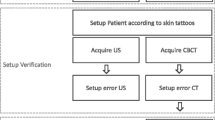Abstract
The accuracy of intracavitary applicator reconstruction for cervical cancer was assessed. A homemade phantom that mimics clinical applicator placement and reference points was used. Three stainless steel (15°, 30°, and 45°) tandems, x-ray markers, and three reference points were used to compare radiography- and CT-based systems. For CT reconstructions, two Fletcher CT compatible (15° and 30°) tandems, two ovoids, and two reference points, with and without inserted x-ray markers, were used. A 2.5-mm CT slice thickness was used. To check for inter- and intra-operator variations in CT, only a 30° tandem without x-ray markers and 1.25-mm CT slice thickness were used. Applicators were reconstructed three times for each image set to verify the operator reproducibility. A 6 Gy dose was prescribed and normalized at AL-point. Source dwell times were compared to check for dose variation at A-point. Maximum standard deviations SD (σ) for radiography and CT reconstructions were 0.35 and 0.83 mm, respectively. Analysis of variance for the means of 15° and 30° tandems showed no significant difference. Levene’s test proved insignificant difference for 15° tandem (p value = 0.131), whereas it showed a significant difference for 30° tandem (p value = 0.011). This phantom study showed that the variance of dwell times between the two methods for 30° tandem was statistically significant due to increased applicator curvature. CT proves superiority to radiography. X-ray marker method was more accurate but has less image quality. Inter- and intra-oncologist variations showed good agreement.







Similar content being viewed by others
References
Tan LT. Implementation of image-guided brachytherapy for cervix cancer in the UK: progress update. Clin Oncol (R Coll Radiol). 2011;23:681–4.
Potter R, Dimopoulos J, Georg P, et al. Clinical impact of MRI assisted dose volume adaptation and dose escalation in brachytherapy of locally advanced cervix cancer. Radiother Oncol. 2007;83:148–55.
Potter R, Haie-Meder C, Limbergen EV, et al. Recommendations from gynaecological (GYN) GEC ESTRO working group (II): concepts and terms in 3D image-based treatment planning in cervix cancer brachytherapy—3D dose volume parameters and aspects of 3D image-based anatomy, radiation physics, radiobiology. Radiother Oncol. 2006;78(1):67–77.
International Commission on Radiological Units and Measurements. ICRU report 38: dose and volume specification for reporting intracavitary therapy in gynecology. Bethesda, MD: ICRU; 1985.
Fellner C, Potter R, Knocke TH, Wambersie A. Comparison of radiography- and computed tomography-based treatment planning in cervix cancer in brachytherapy with specific attention to some quality assurance aspects. Radiother Oncol. 2001;58(1):53–62.
Funding
Part of this study received research fund from the Academic Fellowship Program (Zamalah) for the development of higher education.
Author information
Authors and Affiliations
Corresponding author
Ethics declarations
Conflict of Interest
The authors declare that they have no conflict of interest.
Ethical Approval
This article does not contain any studies with human participants performed by any of the authors.
Informed Consent
This article does not contain any studies with human participants performed by any of the authors and therefore no informed consents were obtained.
Additional information
Publisher’s Note
Springer Nature remains neutral with regard to jurisdictional claims in published maps and institutional affiliations.
This article is part of the Topical Collection on Imaging
Rights and permissions
About this article
Cite this article
ALMasri, H., Kakinohana, Y., Toita, T. et al. Accuracy of Intracavitary Applicator Reconstruction for Cervix Cancer Brachytherapy. SN Compr. Clin. Med. 2, 133–139 (2020). https://doi.org/10.1007/s42399-019-00204-z
Accepted:
Published:
Issue Date:
DOI: https://doi.org/10.1007/s42399-019-00204-z




